Science & Technology - 2017
December
Working to Tame Disturbances in the NIF Force
X-ray Detector Efficiency Boost Wins R&D 100 Award
A Time-Resolved High-Resolution X-ray Spectrometer for NIF
An unusual collaboration among U.S. Department of Energy (DOE) laboratories pursuing different approaches to nuclear fusion has produced the first time-resolved high-resolution x-ray spectrometer for use in NIF inertial confinement fusion and high energy density experiments.
The instrument, the Diagnostic Instrument Manipulator-based High Resolution Spectrometer, or DHIRES, was designed by LLNL’s Andrew MacPhee based on his work at the UK’s Rutherford Appleton Laboratory. The design was verified and implemented by physicists Kenneth Hill, Manfred Bitter, and Lan Gao of the Princeton Plasma Physics Laboratory (PPPL) in collaboration with Joe Kilkenny of General Atomics, who contributed to the dual-channel aspect of the design.
The systems engineering and design team included LLNL’s Jay Ayers and Shannon Ayers along with David Nelson from the University of Rochester’s Laboratory for Laser Energetics (LLE). The spectrometer was assembled and a careful, absolute calibration performed by PPPL backed by image-plate calibration at LLNL.
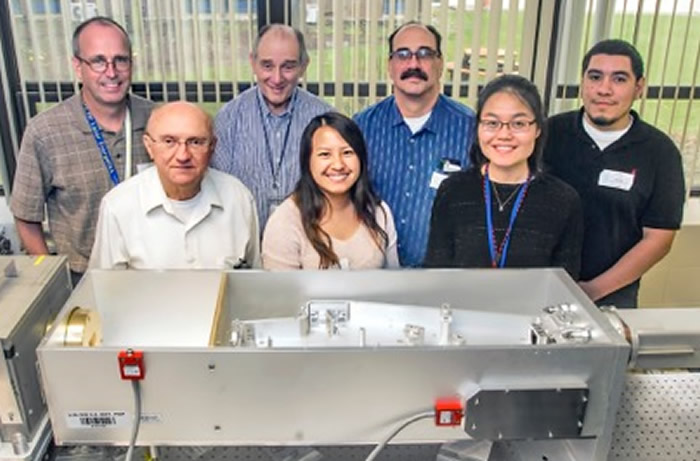 Members of the DHIRES team with the instrument during calibration at PPPL (from left): David Nelson (LLE), Kenneth Hill (PPPL), Philip Efthimion (PPPL), Mai Beach (LLNL), Vern Rekow (LLNL), Lan Gao (PPPL), and Jose Castaneda (LLNL).
Members of the DHIRES team with the instrument during calibration at PPPL (from left): David Nelson (LLE), Kenneth Hill (PPPL), Philip Efthimion (PPPL), Mai Beach (LLNL), Vern Rekow (LLNL), Lan Gao (PPPL), and Jose Castaneda (LLNL). DHIRES, which is one of the “transformational” diagnostics, is designed to record high-resolution spectral data from krypton doped into the fuel of imploding capsules used in ignition and HED experiments. The spectrometer uses two conically curved crystals to focus the krypton spectral lines onto the slit of a streak camera with a spectral resolution of about 10 electron volts. The streak camera, known as DISC, was recently redesigned to improve its spatial and temporal resolution.
A third DHIRES channel records spectra from a cylindrically curved crystal onto image plate and is used for an in-situ calibration of the streaked data. The spectra can be analyzed to diagnose the electron temperature and density of the stagnating plasma in a NIF implosion.
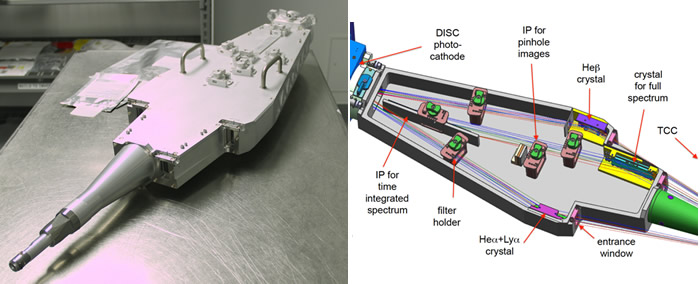 Left: Body of the time-resolved DHIRES spectrometer. Right: CAD model of DHIRES showing the internal parts including the three crystals.
Left: Body of the time-resolved DHIRES spectrometer. Right: CAD model of DHIRES showing the internal parts including the three crystals. DHIRES was first tested on a NIF polar direct drive exploding pusher target on Sept. 28. The data successfully demonstrated that DHIRES, along with the improved DISC, could meet the diagnostic requirements.
Experiments to meet the physics requirements for DHIRES began on Nov. 2. In this campaign, DHIRES will be used to accurately measure electron temperature and density during NIF implosions.
“Measuring these conditions is key to achieving ignition of a self-sustaining fusion process on NIF,” said PPPL physicist Lan Gao. “The fusion yield is very sensitive to temperature,” added Marilyn Schneider, leader of NIF’s Radiation Physics and Spectroscopic Diagnostics Group. 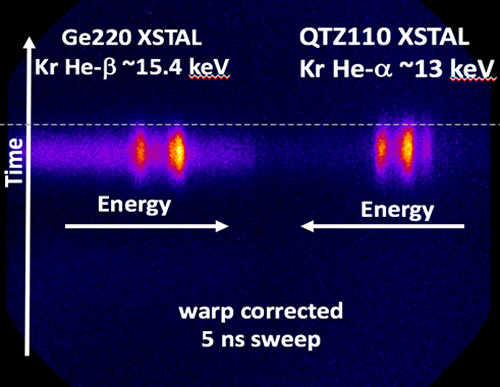 Time-resolved krypton-helium-like spectral lines from a NIF polar direct drive exploding pusher target recorded by DHIRES. “The spectrometer will provide the most sensitive temperature measurements to date. The device’s ability to plot temperature against time will also be very helpful.”
Time-resolved krypton-helium-like spectral lines from a NIF polar direct drive exploding pusher target recorded by DHIRES. “The spectrometer will provide the most sensitive temperature measurements to date. The device’s ability to plot temperature against time will also be very helpful.”
PPPL, which studies magnetic confinement fusion, uses spectrometers to analyze the electromagnetic spectrum of plasma, the hot fourth state of matter in which electrons have separated from atomic nuclei, inside doughnut-shaped fusion devices known as tokamaks. These devices heat the particles and confine them in magnetic fields, causing the nuclei to fuse and produce fusion energy. In contrast, NIF’s high-energy lasers cause fusion by compressing and heating tiny pellets filled with isotopes of hydrogen.
NIF experiments are relevant to projects that include the U.S. Stockpile Stewardship Program, which maintains the nation’s nuclear deterrent without full-scale testing; other national security-related studies; and fundamental Discovery Science explorations of astrophysics, planetary physics, material science, and many other fields.
LLNL researchers Schneider, Shirley Person, Dave Bradley, and Perry Bell also contributed to the project, along with PPPL physicist Phil Efthimion, head of PPPL’s Plasma Science & Technology Department, and PPPL graduate student Brian Kraus.
Working to Tame Disturbances in the NIF Force
To fuel NIF’s powerful target-capsule implosions, miniscule syringes called fill tubes inject hydrogen gas into the capsules that NIF’s lasers then obliterate in a flash of energy hotter than the Sun.
In a notable shift from previous practice, a research team led by physicist Vladimir Smalyuk is deliberately bending the tiny fill tubes that, until now, have been as straight as steel pipes. The team is experimenting with this diversionary bend in the target fabrication process to better diagnose and understand the importance of the fill tube to implosion performance, with the ultimate goal of increasing NIF’s neutron yield.
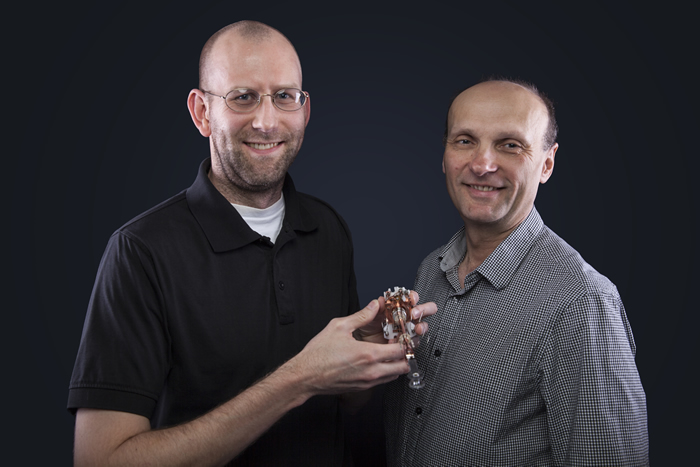 Target engineer Steve Johnson, left, and physicist Vladimir Smalyuk with a NIF target of the type used in fill-tube experiments. They are helping lead a campaign to test the effects of bent fill tubes on NIF implosions. Credit: Mark Meamber
Target engineer Steve Johnson, left, and physicist Vladimir Smalyuk with a NIF target of the type used in fill-tube experiments. They are helping lead a campaign to test the effects of bent fill tubes on NIF implosions. Credit: Mark Meamber Smalyuk is experimental co-leader of the Inertial Confinement Fusion (ICF) Capsule Science Group in the NIF & Photon Science Directorate along with Harry Robey of the Lab’s Weapons and Complex Integration Directorate.
The bent fill tube is among a number of approaches researchers are taking to try to reduce the impact of fill tubes and other sources of hydrodynamic instabilities that interfere with NIF implosions. They have experimented with reducing the size of the fill tubes by as much as half, from 10 microns to 5 microns in diameter, in experiments that have been shown to boost NIF’s neutron yield significantly. Minimizing the effects of the gossamer-thin plastic membranes, or “tents,” that suspend the fuel capsules in the hohlraum is another avenue to improve NIF implosions.
To put the size of these microscopic fill tubes in perspective, the size of a human hair ranges from about 30 to 100 microns thick. Additionally, the fill tubes are made of glass, making the tiny fuel lines extremely fragile.
The tubes always have been considered a necessary intrusion in ICF implosions, like a weld seam on a pipe. But tiny as fill tubes are, research shows they can cause significant hydrodynamic perturbations that can interfere with NIF’s performance.
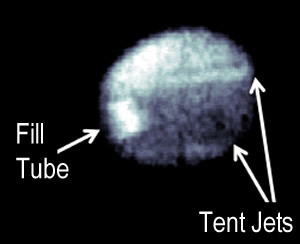 Image taken during a NIF implosion by the Kirkpatrick-Baez x-ray microscope shows the perturbations caused by the standard fill tube and the ultra-thin tents that suspend the target capsule in the hohlraum. The image was captured at 190 picoseconds (trillionths of a second) before “bang time,” the moment of peak x-ray emission.
Image taken during a NIF implosion by the Kirkpatrick-Baez x-ray microscope shows the perturbations caused by the standard fill tube and the ultra-thin tents that suspend the target capsule in the hohlraum. The image was captured at 190 picoseconds (trillionths of a second) before “bang time,” the moment of peak x-ray emission. The Capsule Science Group has set out to measure just how much of an impact fill tubes make on NIF conditions, and then modify the angles in the tube to minimize the perturbations. The fill tube campaign “will give a better understanding of what this fill tube does to performance,” Smalyuk explained. “And if it (bending the tube) really mitigates the perturbation, it will give us improved performance. We don’t know without trying it.”
The team includes members from the Capsule Science, Target Fabrication, and Integrated Implosions groups. They completed their first major experiment in the campaign in March to measure perturbations of the bent fill tube through a hohlraum diagnostic port. The team members are now developing their second experimental campaign, with the next experiment scheduled for March of next year.
Normally the fill tube exits the target capsule in a straight line and doesn’t line up with any diagnostic instruments, target engineer Steve Johnson explained. But to measure the perturbations caused by the fill tube, the fill tube hole must be aligned with a diagnostic port in the hohlraum so the diagnostics have direct access to the fill tube’s effects. The hohlraum’s diagnostic ports are covered by high-density carbon windows, and the fill tube can’t penetrate the windows, so the tubes must bend around the windows to exit the hohlraum.
Johnson’s team worked on the problem of how to actually bend the extremely delicate fill tubes, and were able to manipulate the needle-thin tubes to apply an approximately 14-degree bend angle and maneuver them around the diagnostic port windows.
The team’s main challenge was bending the glass tube while maintaining capsule orientation to allow measurements of the perturbations caused by the fill tube. Early test build attempts showed that, after bending, the fill tube would tend to relax and shift the capsule’s orientation, making the perturbations less visible during the experiment. The researchers evaluated and tested variations of tent designs until they observed no bend relaxation or capsule shift.
“We’ve never intentionally bent a fill tube before,” Johnson said. “We wondered whether it was going to be like spaghetti, or a spring, and go back to straight shape; (or) is it going to affect the centering of the capsule, or do something weird?”
“It’s not a simple thing, getting these measurements,” Smalyuk added. “That’s basic experimental science. You have your hypothesis, (and) you want to come up with experiments that test your hypothesis.”
Working on the bent fill tube campaigns along with Smalyuk, Robey, and Johnson are: in Capsule Science: Chris Weber, Dan Clark, Bruce Hammel, Jose Milovich, Andrew MacPhee, and David Martinez; in Integrated Implosions: Laura Berzak Hopkins and Sebastien Le Pape; in Target Fabrication: Michael Stadermann, Sean Felker, Abbas Nikroo, John Bigelow, Scott Vonhof, Hans Truax, Silverio Diaz, Cresenciano Alday, Jaime Cortez, Steve Gross, and Thomas Bunn; and from General Atomics: Karina Kangas, Javier Jaquez, Neal Rice, and Jay Crippen.
X-ray Detector Efficiency Boost Wins R&D 100 Award
Technology that improves high-energy efficiency in x-ray detectors has been named one of the top 100 industrial inventions worldwide for 2017 by R&D Magazine. The geometrically enhanced photocathodes for x-ray detectors were developed by LLNL researchers in collaboration with the Nevada National Security Site, General Atomics, Lawrence Berkeley National Laboratory, and NanoShift, LLC.
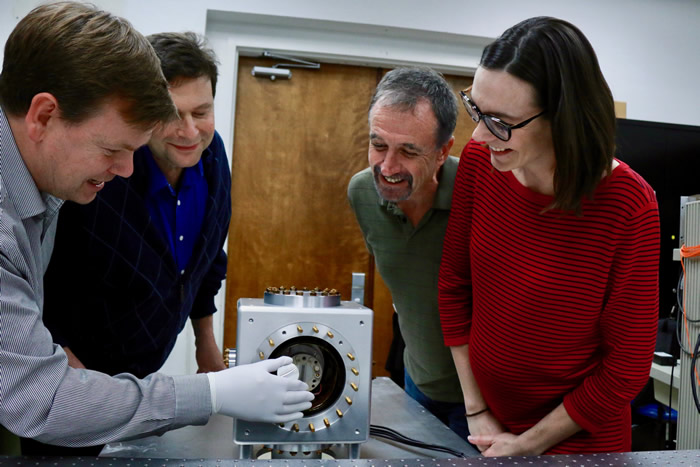 Members of the geometrically enhanced photocathode development team (from left) Andrew MacPhee, Nino Landen, Dave Bradley, and Sabrina Nagel examine the photocathode in an x-ray streak camera that could use the new photocathode. Team members Kathy Opachich of NNSS and Perry Bell of LLNL are not pictured. Credit: Maren Hunsberger
Members of the geometrically enhanced photocathode development team (from left) Andrew MacPhee, Nino Landen, Dave Bradley, and Sabrina Nagel examine the photocathode in an x-ray streak camera that could use the new photocathode. Team members Kathy Opachich of NNSS and Perry Bell of LLNL are not pictured. Credit: Maren Hunsberger The trade journal R&D Magazine announced the winners of the annual awards, known as the “Oscars of invention,” last month at the Walt Disney World Swan Resort in Orlando, Florida. LLNL won a total of seven awards. With this year’s results, the NIF & Photon Science Directorate and its predecessor, the Laser Programs Directorate, have captured 64 R&D 100 awards out of a total of 165 won by the Laboratory since 1978.
Photocathodes—“photoemissive” material that emits electrons when exposed to light or other radiation—are used to convert incident light photons into electrons. X-ray detector efficiency and performance have been largely limited by the total quantum electron yield, with a quantum efficiency rate of only about 1 percent.
By changing the geometry of the photocathodes, that barrier has been broken, achieving quantum efficiencies of three times that of traditional photocathodes at high x-ray energies.
This breakthrough is adaptable to any x-ray detector, allowing for ease of use without compromising performance.





